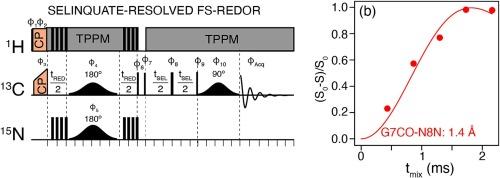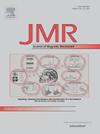同核 J耦合和异核结构约束。
IF 1.9
3区 化学
Q3 BIOCHEMICAL RESEARCH METHODS
引用次数: 0
摘要
在涉及均匀 13C/15N 标记蛋白质的魔角旋光(MAS)实验中,13C-13C 和 13C-15N 偶极再偶联实验现在已被常规用于测量直接偶极-偶极耦合,从而约束距离和扭转角并确定分子结构。当距离较短时(13C-13C 和 13C-15N J耦合(标量耦合)被忽略。然而,对于具有结构意义的大于 4 Å 的距离,偶极耦合和 J 耦合的量级通常相当,为了优化实验精度,J 的变化必须包括在内。在光谱解析度较高的情况下,可以通过使用频率选择性偶极再偶联方法来规避这一问题,在这种方法中,J 偶联的影响被重新聚焦。然而,对于具有更多光谱拥挤的较大分子,实现选择性所需的脉冲长度变得很长,导致脉冲期间出现不可接受的灵敏度损失,或者光谱重叠排除了选择性激发。在本文中,我们通过两种方法来解决这一问题,旨在促进在未完全解析的系统中进行更高精度的核间距测量。即:(1) 我们描述了一种利用同相反相(IPAP)序列高精度测量特定 J 偶合的方法,该方法被集成到非选择性偶极再耦合技术中;(2) 我们利用测量到的 J 偶合来实施双量子滤波器实验,该实验能够提供频率选择性偶极再耦合技术所需的分辨率,而无需诉诸多维光谱学。我们使用淀粉样蛋白 Sup-35p 蛋白的一个 7 肽段 U-13C/15N-GNNQQNY 来说明这些方法,我们测量了 27 个可能的单键 13C-13C J 耦合中的 25 个。本文章由计算机程序翻译,如有差异,请以英文原文为准。

Homonuclear J-couplings and heteronuclear structural constraints
In magic angle spinning (MAS) experiments involving uniformly 13C/15N labeled proteins, 13C–13C and 13C–15N dipolar recoupling experiments are now routinely used to measure direct dipole–dipole couplings that constrain distances and torsion angles and determine molecular structures. When the distances are short (<4 Å), the direct couplings dominate the evolution of the spin system, and the 13C–13C and 13C–15N J-couplings (scalar couplings) are ignored. However, for structurally interesting >4 Å distances, the dipolar and J-couplings are generally of comparable magnitude, and the variation in J must be included in order to optimize the precision of the experiment. This problem is circumvented in cases with well resolved spectra by using frequency-selective dipolar recoupling methods where the effects of J-couplings are refocused. However, for larger molecules with more spectral crowding, the requisite pulse length to achieve selectivity becomes long and leads to unacceptable sensitivity losses during the pulse or the spectral overlap precludes selective excitation. In this paper, we address this problem with two approaches aimed at facilitating higher precision internuclear distance measurements in systems that are not fully resolved. Namely, (1) we describe an approach for high precision measurements of specific J-couplings using the in-phase anti-phase (IPAP) sequence which is integrated into a non-selective dipolar recoupling technique and (2) we utilize the measured J-couplings to implement a double quantum filter experiment capable of providing the resolution necessary for frequency selective dipolar recoupling techniques without resorting to multidimensional spectroscopy. We illustrate these methods using a 7-peptide segment from the amyloidogenic Sup-35p protein, U-13C/15N-GNNQQNY, where we have measured 25 of the 27 possible one bond 13C–13C J-couplings.
求助全文
通过发布文献求助,成功后即可免费获取论文全文。
去求助
来源期刊
CiteScore
3.80
自引率
13.60%
发文量
150
审稿时长
69 days
期刊介绍:
The Journal of Magnetic Resonance presents original technical and scientific papers in all aspects of magnetic resonance, including nuclear magnetic resonance spectroscopy (NMR) of solids and liquids, electron spin/paramagnetic resonance (EPR), in vivo magnetic resonance imaging (MRI) and spectroscopy (MRS), nuclear quadrupole resonance (NQR) and magnetic resonance phenomena at nearly zero fields or in combination with optics. The Journal''s main aims include deepening the physical principles underlying all these spectroscopies, publishing significant theoretical and experimental results leading to spectral and spatial progress in these areas, and opening new MR-based applications in chemistry, biology and medicine. The Journal also seeks descriptions of novel apparatuses, new experimental protocols, and new procedures of data analysis and interpretation - including computational and quantum-mechanical methods - capable of advancing MR spectroscopy and imaging.

 求助内容:
求助内容: 应助结果提醒方式:
应助结果提醒方式:


